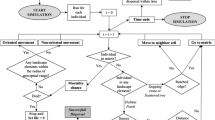Abstract
Habitat fragmentation is expected to disrupt dispersal, and thus we explored how patch metrics of landscape structure, such as percolation thresholds used to define landscape connectivity, corresponded with dispersal success on neutral landscapes. We simulated dispersal as either a purely random process (random direction and random step lengths) or as an area-limited random walk (random direction, but movement limited to an adjacent cell at each dispersal step) and quantified dispersal success for 1000 individuals on random and fractal landscape maps across a range of habitat abundance and fragmentation. Dispersal success increased with the number of cells a disperser could search (m), but poor dispersers (m<5) searching via area-limited dispersal on fractal landscapes were more successful at locating suitable habitat than random dispersers on either random or fractal landscapes. Dispersal success was enhanced on fractal landscapes relative to random ones because of the greater spatial contagion of habitat. Dispersal success decreased proportionate to habitat loss for poor dispersers (m=1) on random landscapes, but exhibited an abrupt threshold at low levels of habitat abundance (p<0.1) for area-limited dispersers (m<10) on fractal landscapes. Conventional metrics of patch structure, including percolation, did not exhibit threshold behavior in the region of the dispersal threshold. A lacunarity analysis of the gap structure of landscape patterns, however, revealed a strong threshold in the variability of gap sizes at low levels of habitat abundance (p<0.1) in fractal landscapes, the same region in which abrupt declines in dispersal success were observed. The interpatch distances or gaps across which dispersers must move in search of suitable habitat should influence dispersal success, and our results suggest that there is a critical gap-size structure to fractal landscapes that interferes with the ability of dispersers to locate suitable habitat when habitat is rare. We suggest that the gap structure of landscapes is a more important determinant of dispersal than patch structure, although both are ultimately required to predict the ecological consequences of habitat fragmentation.
Similar content being viewed by others
References
Allain, C., and Cloitre, M. 1991. Characterizing the lacunarity of random and deterministic fractal sets. Physical Review A 44: 3552–3558.
Andrén, H. 1994. Effects of habitat fragmentation on birds and mammals in landscapes with different proportions of suitable habitat: a review. Oikos 71: 355–366.
Doak, D.F., Marino, P.C., and P.M. Kareiva. 1992. Spatial scale mediates the influence of habitat fragmentation on dispersal success: implications for conservation. Theoretical Population Biology 41: 315–336.
Fahrig, L. 1997. Relative effects of habitat loss and fragmentation on population extinction. Journal of Wildlife Management 61: 603–610.
Fahrig, L, and Merriam, G. 1985. Habitat patch connectivity and population survival. Ecology 66: 1762–1768.
Fahrig, L., and Paloheimo, J. 1988. Determinants of local population size in patchy habitats. Theoretical Population Biology 34: 194–213.
Gardner, R.H. 1998. RULE: a program for the generation and analysis of landscape pattern. In press in Landscape ecological analysis: issues and applications (J.M. Klopatek, and R.H. Gardner, editors). Springer-Verlag, New York.
Gardner, R.H., and O'Neill, R.V. 1991. Pattern, process and predictability: the use of neutral models for landscape analysis. In Quantitative methods in landscape ecology. pp. 289–307. Edited by M. G. Turner and R.H. Gardner. Springer-Verlag, New York.
Gardner, R.H., Milne, B.T., Turner, M.G., and O'Neill, R.V. 1987. Neutral models for the analysis of broad-scale landscape pattern. Landscape Ecology 1: 19–28.
Gardner, R.H., O'Neill, R.V., and Turner, M.G. 1993. Ecological implications of landscape fragmentation. In Humans as components of ecosystems: subtle human effects and ecology of populated areas. pp. 208–226. Edited by S.T.A. Pickett and M.G. McDonnell. Springer-Verlag, New York.
Gardner, R.H., O'Neill, R.V., Turner, M.G., and Dale, V.H. 1989. Quantifying scale-dependent effects of animal movement with simple percolation models. Landscape Ecology 3: 217–227.
Greenwood, P.J. 1980. Mating systems, philopatry and dispersal in birds and mammals. Animal Behaviour 28: 1140–1162.
Greenwood, P.J., and Harvey, P.H. 1982. The natal and breeding dispersal of birds. Annual Review of Ecology and Systematics 13: 1–21.
Gustafson, E.J., and Gardner, R.H. 1996. The effect of landscape heterogeneity on the probability of patch colonization. Ecology 77: 94–107.
Hansson, L. 1991. Dispersal and connectivity in metapopulations. Biological Journal of the Linnean Society 42: 89–103.
Kareiva, P. 1990. Population dynamics in spatially complex environments: theory and data. Philosophical Transactions of the Royal Society of London B330: 175–190.
Lande, R. 1987. Extinction thresholds in demographic models of territorial populations. American Naturalist 130: 624–635.
Mandelbrot, B.B. 1983. The fractal geometry of nature. W.H. Freeman and Company, NewYork.
O'Neill, R.V., Milne, B.T., Turner, M.G., and Gardner, R.H. 1988. Resource utilization scales and landscape pattern. Landscape Ecology 2: 63–69.
O'Neill, R.V., Krummel, J.R., Gardner, R.H., Sugihara, G., Jackson, B., DeAngelis, D.L., Milne, B.T., Turner, M.G., Zygmunt, B., Christensen, S.W., Dale, V.H., and Graham, R.L. 1988. Indices of landscape pattern. Landscape Ecology 1: 153–162.
Opdam, P. 1990. Dispersal in fragmented populations: the key to survival. In Species dispersal in agricultural habitats. pp. 3–17. Edited by R.G.H. Bunce and D.C. Howard. Belhaven Press, New York.
Pearson, S.M., Turner, M.G., Gardner, R.H., and O'Neill, R.V. 1996. An organism-based perspective of habitat fragmentation. In Biodiversity in managed landscapes: theory and practice. pp. 77–95. Edited by R.C. Szaro and D.W. Johnston. Oxford University Press, Oxford.
Pickett, S.T.A., and Cadenasso, M.L. 1995. Landscape ecology: spatial heterogeneity in ecological systems. Science 269: 331–334.
Plotnick, R.E., and Gardner, R.H. 1993. Lattices and landscapes. In Lectures on mathematics in the life sciences: predicting spatial effects in ecological systems, vol. 23. pp. 207–224. Edited by R.H. Gardner. American Mathematical Society, Providence, Rhode Island.
Plotnick, R.E., Gardner, R.H., and O'Neill, R.V. 1993. Lacunarity indices as measures of landscape texture. Landscape Ecology 8: 201–211.
Plotnick, R.E., Gardner, R.H., Hargrove, W.W., Prestegaard, K., and Perlmutter, M. 1996. Lacunarity analysis: a general technique for the analysis of spatial patterns. Physical Review E 53: 5461–5468.
Saupe, D. 1988. Algorithms for random fractals. In The science of fractal images. pp. 71–113. Edited by H.-O. Petigen and D. Saupe. Springer, New York.
Schumaker, N. 1996. Using landscape indices to predict habitat connectivity. Ecology 77: 1210–1225.
Taylor, P.D., Fahrig, L, Henein, K., and Merriam, G. 1993. Connectivity is a vital element of landscape structure. Oikos 68: 571–573.
Turner, M.G. 1989. Landscape ecology: the effect of pattern on process. Annual Review of Ecology and Systematics 20: 171–197.
Turner, M.G., and Gardner, R.H., editors. 1991. Quantitative methods in landscape ecology. Springer-Verlag, New York.
Walsh, P.D. 1996. Area-restricted search and scale dependence of patch quality discrimination. Journal of Theoretical Biology 183: 351–361.
Wiens, J.A., Stenseth, N.C., Van Horne, B., and Ims, R.A. 1993. Ecological mechanisms and landscape ecology. Oikos 66: 369–380.
Wiens, J.A., Schooley, R.L., and Weeks, Jr., R.D. 1997. Patchy landscapes and animal movements: do beetles percolate? Oikos 78: 257–264.
With, K.A. 1997. The application of neutral landscape models to conservation biology. Conservation Biology 11: 1069–1080.
With, K.A., and Crist, T.O. 1995. Critical thresholds in species' responses to landscape structure. Ecology 76: 2446–2459.
With, K.A., and King, A.W. 1997. The use and misuse of neutral landscape models in ecology. Oikos 79: 219–229.
With, K.A., and King, A.W. in press. Extinction thresholds for species in fractal landscapes. Conservation Biology.
With, K.A., Gardner, R.H., and Turner, M.G. 1997. Landscape connectivity and population distributions in heterogeneous environments. Oikos 78: 151–169.
Author information
Authors and Affiliations
Rights and permissions
About this article
Cite this article
With, K.A., King, A.W. Dispersal success on fractal landscapes: a consequence of lacunarity thresholds. Landscape Ecology 14, 73–82 (1999). https://doi.org/10.1023/A:1008030215600
Issue Date:
DOI: https://doi.org/10.1023/A:1008030215600




